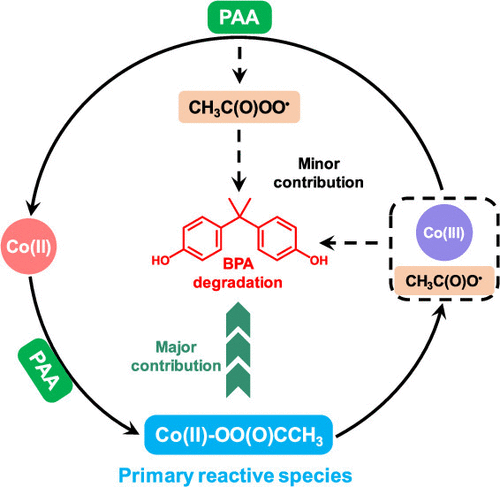当前位置:
X-MOL 学术
›
ACS ES&T Eng.
›
论文详情
Our official English website, www.x-mol.net, welcomes your
feedback! (Note: you will need to create a separate account there.)
New Insights into the Activation of Peracetic Acid by Co(II): Role of Co(II)-Peracetic Acid Complex as the Dominant Intermediate Oxidant
ACS ES&T Engineering ( IF 7.4 ) Pub Date : 2021-08-23 , DOI: 10.1021/acsestengg.1c00166 Zihao Zhao 1 , Xinhong Li 1 , Hongchao Li 1 , Jieshu Qian 1, 2 , Bingcai Pan 2
ACS ES&T Engineering ( IF 7.4 ) Pub Date : 2021-08-23 , DOI: 10.1021/acsestengg.1c00166 Zihao Zhao 1 , Xinhong Li 1 , Hongchao Li 1 , Jieshu Qian 1, 2 , Bingcai Pan 2
Affiliation

|
The combination of Co(II) and peracetic acid (PAA) is an important alternative advanced oxidation process (AOPs), in which R-O• radicals including acetyloxyl radicals (CH3C(O)O•) and acetylperoxyl radicals (CH3C(O)OO•) have been considered to be the primary reactive species for the oxidative degradation of contaminants. However, it is still unclear how the active Co species participates in this process. In this study, we conduct a series of experiments including chemical probing, radical quenching, electron paramagnetic resonance (EPR), and Co(III) oxidation to investigate the degradation mechanism of contaminants in the Co(II)/PAA process, using bisphenol A (BPA) as target pollutant. On the basis of these results, we propose a Co(II)-PAA complex (Co(II)-OO(O)CCH3) to be the primary reactive species, while R-O• radicals and Co(III) (available as dimeric Co-peroxide species) derived from the decomposition of Co(II)-PAA complex are the minor contributors for the oxidation of BPA. Factors, including PAA concentration, Co(II) concentration, solution pH, inorganic anions, and natural organic matters (NOM), that might affect the oxidation performance of the Co(II)/PAA process were also investigated systematically. This study sheds new light on the mechanistic understanding of the Co(II)/PAA process for the oxidation of contaminants in water.
中文翻译:

Co(II) 活化过乙酸的新见解:Co(II)-过氧乙酸复合物作为主要中间氧化剂的作用
Co(II) 和过乙酸 (PAA) 的结合是一种重要的替代高级氧化过程 (AOP),其中 RO •自由基包括乙酰氧基自由基 (CH 3 C(O)O • ) 和乙酰过氧基自由基 (CH 3 C( O)OO •) 被认为是污染物氧化降解的主要反应物质。然而,目前尚不清楚活性 Co 物种如何参与该过程。在本研究中,我们进行了一系列实验,包括化学探测、自由基猝灭、电子顺磁共振 (EPR) 和 Co(III) 氧化,以研究使用双酚 A 的 Co(II)/PAA 过程中污染物的降解机制。 (BPA) 作为目标污染物。基于这些结果,我们建议将 Co(II)-PAA 复合物 (Co(II)-OO(O)CCH 3 ) 作为主要的反应性物质,而 RO •由 Co(II)-PAA 复合物分解产生的自由基和 Co(III)(可作为二聚 Co-过氧化物物种获得)是 BPA 氧化的次要贡献者。还系统地研究了可能影响 Co(II)/PAA 工艺氧化性能的因素,包括 PAA 浓度、Co(II) 浓度、溶液 pH 值、无机阴离子和天然有机物 (NOM)。这项研究揭示了对 Co(II)/PAA 过程氧化水中污染物的机理的理解。
更新日期:2021-10-08
中文翻译:

Co(II) 活化过乙酸的新见解:Co(II)-过氧乙酸复合物作为主要中间氧化剂的作用
Co(II) 和过乙酸 (PAA) 的结合是一种重要的替代高级氧化过程 (AOP),其中 RO •自由基包括乙酰氧基自由基 (CH 3 C(O)O • ) 和乙酰过氧基自由基 (CH 3 C( O)OO •) 被认为是污染物氧化降解的主要反应物质。然而,目前尚不清楚活性 Co 物种如何参与该过程。在本研究中,我们进行了一系列实验,包括化学探测、自由基猝灭、电子顺磁共振 (EPR) 和 Co(III) 氧化,以研究使用双酚 A 的 Co(II)/PAA 过程中污染物的降解机制。 (BPA) 作为目标污染物。基于这些结果,我们建议将 Co(II)-PAA 复合物 (Co(II)-OO(O)CCH 3 ) 作为主要的反应性物质,而 RO •由 Co(II)-PAA 复合物分解产生的自由基和 Co(III)(可作为二聚 Co-过氧化物物种获得)是 BPA 氧化的次要贡献者。还系统地研究了可能影响 Co(II)/PAA 工艺氧化性能的因素,包括 PAA 浓度、Co(II) 浓度、溶液 pH 值、无机阴离子和天然有机物 (NOM)。这项研究揭示了对 Co(II)/PAA 过程氧化水中污染物的机理的理解。











































 京公网安备 11010802027423号
京公网安备 11010802027423号